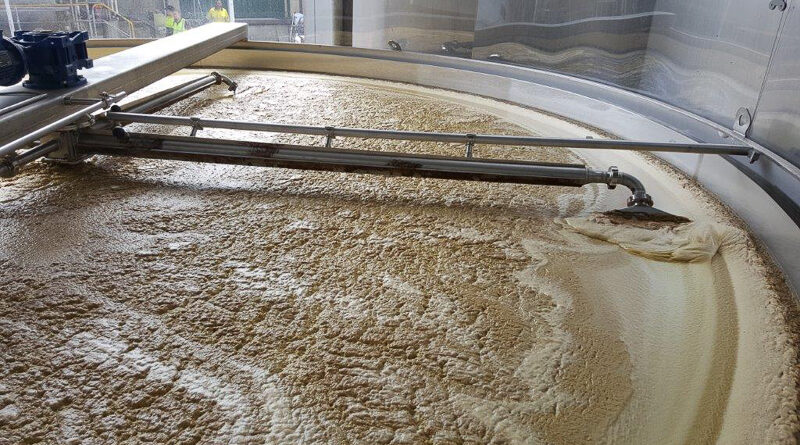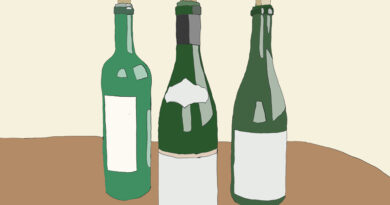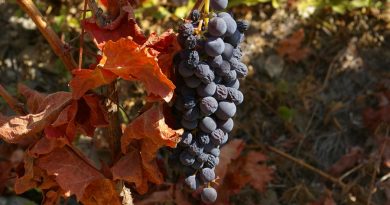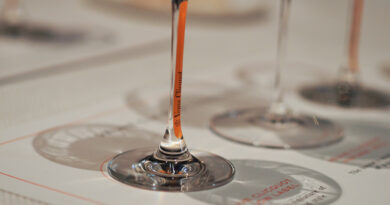Must clarification by flotation
How clean do you want your juice? When white wines are pressed, the grape juice that comes out is pretty murky. The grapes are sometimes covered in dust, but even when they are clean, the juice isn’t clear. [As an aside, there is a winery in Franciacorta, Ca’Del Bosco, that washes their grapes before fermentation in a ‘berry spa’[1].] There are some winemakers that take the juice straight out of the press pan to barrel, but this is quite rare, and can result in high solids fermentation in some of the barrels that then risk the development of reductive aromas. It follows that winemakers looking for a bit of reduction sometimes deliberately do a high solids ferment, and I also know some winemakers who take the juice from the press, then stir it in a tank before going to barrel so that each has the same level of high solids: here, they are deliberately toying with a bit of reduction to get some matchstick/flint character into the wine. But, in most cases, after pressing whites and rosés, it’s normal for winemakers to clarify the must before fermentation
The traditional way of doing clarification is cold settling. Here, juice goes from the press to a tank and is usually kept overnight at a low-ish temperature (to stop fermentation beginning) in order to allow the solids to fall to the bottom. The next day, or when the juice has cleared to the chosen level, it will be decanted off and fermentation is started. Sometimes pectolytic enzymes are used to help speed the process. Winemakers often have an idea of the sort of clarity they want in the juice. It is measured in terms of NTUs (nephelometric turbidity units), and from the press the typical level would be 500-600. For most winemakers about 100 is the optimum level, but some go as low as 50. The benefit of working with cleaner juice is that often the wines are cleaner and fruitier. But if the juice is too clear, then there can be problems with fermentation as there might not be enough nutrients to feed the yeasts.
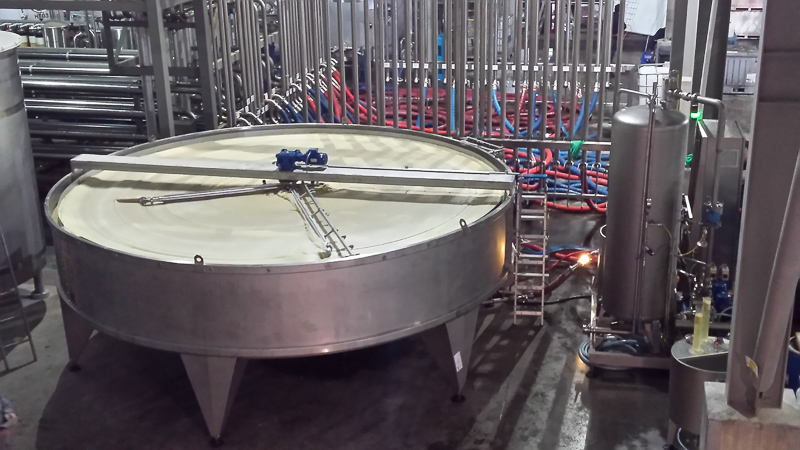
Flotation is an alternative way of clarifying must. It’s not a new technique – it was transplanted to wine from the Australian mining industry in the late 1970s, but it only really took off fairly recently. Now it is becoming widely adopted, and a survey of Australian wineries in 2016 indicated that they considered it to be the second most significant recent technological change in their winemaking after the cross-flow filter.
The concept behind flotation is quite intriguing. Rather than let the solids slowly settle to the bottom of a tank, nitrogen or air is introduced to the must at pressure. Then small gas bubbles form in the saturated juice and as these float to the top they take the solids with them (these bubbles combines with solids are called ‘flocs’). The cleared juice is then taken from below this foam.
It’s common to add things to the must to facilitate the process. Pectolytic enzymes are often used to break up compounds from cell walls called pectins, which cause the juice to be hazy and more viscous. The pectins have a negative charge and surround positively charged proteins in the juice. These enzymes aid clarification by breaking the pectins into smaller fragments. The other addition is adjuvants such as gelatin, bentonite (a montmorillonite clay that is also used to fine white wines before bottling to make them heat stable) and silica. Bentonite is negatively charged and attracts positively charged proteins. Gelatine is mainly negatively charged and strengthens the flocs, helping the gas bubbles to stick to them. Silica helps create large flocs, and can be used with gelatin, but needs to be added first. These adjuvants will inactivate any enzymes that are present, so if enzymes are used then need to be added first. There are also some plant protein adjuvants which can be used instead of gelatin (which is animal-derived) for vegan-friendly wines.
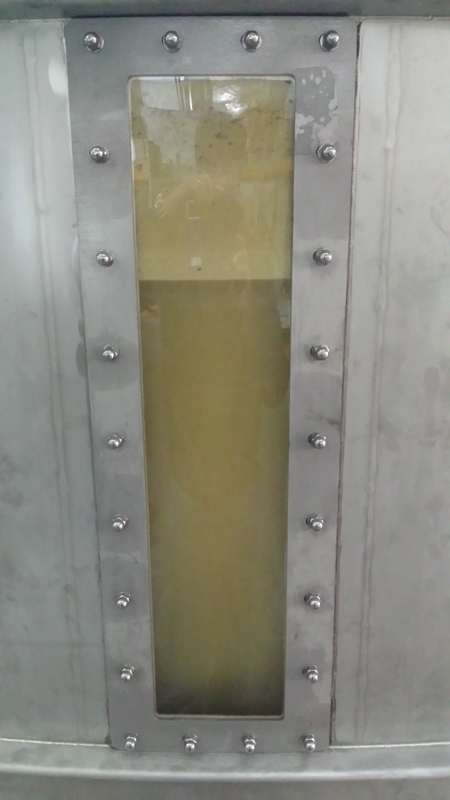
There are two ways of doing flotation: batch or continuous. Batch is when it is done in a single tank, using an adapted pump. The adjuvant (if used) is added to the tank, then the must is saturated with the gas (to a pressure of 5-7 bars). Flotation takes place and the clarified liquid is transferred to another tank. Continuous flotation involves specialist tanks and a more complicated set up, but it is faster. Here, there is a separation tank where the must is treated with adjuvant and then saturated with nitrogen or air. It’s then transferred to a shallow, cylindrical flotation tank where a rotating arm with a suction device scoops off the floated foam from the top, and the clarified juice is continuously removed from below. The floats that have been sucked of the surface can then be filtered with a lees recovery filter (known as RVD for ‘rotary vacuum drum’), a centrifuge or a high-solids crossflow filter. Batch flotation can typically do 5000 litres and hour, whereas continuous flotation can do 40 000 litres an hour.
One choice facing winemakers who use flotation is which gas to choose. Argon is inert and would work well but is too expensive. Nitrogen is also inert and is usually the gas of choice. Compressed air is the cheapest, and is sometimes used. But it contains 20% oxygen, so for some wine styles it is not appropriate as it might oxidise some juice aromatic compounds. In some situations it is desirable though, because it can oxidise some of the juice phenolics that can later cause problems for white wines. Carbon dioxide doesn’t work well because the bubbles are too big.
The great advantage of flotation is that it saves time. Juice can be in the fermentation tank within hours rather than a day. This technique has been particularly well received in New Zealand’s Marlborough region, where Sauvignon Blanc is the dominant grape variety and vintage can be very compressed, with all the grapes coming in at the same time.
Pernod Ricard, owners of Brancott Estate, have adopted continuous flotation. They take out the clear juice and the floats then go through centrifuges to get any remaining juice out. The advantage is that within 24 hours everything is inoculated and ready to ferment. This is the key to getting clean wines in vintages like 2017 when there was quite a bit of botrytis about: because flotation is quick, the juice only has limited time in contact with any of the botrytis products that might be in the must.
Villa
Maria, another major player in the region, also use it. ‘Yes, we have a
continuous float unit for SB juice,’ says the chief Marlborough winemaker Helen
Morrison. ‘These days we use just nitrogen gas and small dose of bentonite.’
Villa Maria also have a centrifuge. And Natalie Christensen, chief winemaker at
Yealands, says that they do both continuous and batch flotation. ‘For continuous float
we use a bentonite called Flottobent at a super low rate (0.36ng/L) along with
nitrogen,’ she says. ‘And for batch floating we use nothing – just nitrogen.’
[1] What does washing grapes achieve? There aren’t any peer reviewed scientific papers on it, but I did find a paper from an Italian group led by Agostino Cavazza presented at a symposium on Microbial Food Safety of Wine in Vilfranca de Penedès, Spain in 2007. The authors evaluated the effects of grape washing at the Pojer & Sandri winery in Trentino, in a winery scale trial in the 2007 vintage. They used 12 tons of Müller Thurgau and 4 tons of Cabernet Sauvignon, washing half of each. Then they compared three treatments for each: spontaneous ferment, inoculated ferment and ferment started with a pied de cuve (a small, prior spontaneous fermentation that is then checked for quality, and if good enough, added to the must to get things going). The washing unit was the CLU Grapeclean unit from Technicapompe Zanin. The grapes are washed for 3-6 minutes in a 1% citric acid solution bubbled by air, and are then rinsed, and then dried in an air flow. The results showed a difference. The must of the unwashed grapes had a higher yeast content, mostly non-Saccharomyces species. But the wild ferments worked fine in both cases. The washing also removed traces of pesticide, although these were low in the unwashed grapes because it had been a dry season. For the red wines, there were lower metal ion levels (iron, copper, zinc and lead) in the washed grapes. There was no sensory work on the wines looking at the flavour effects of washing.

